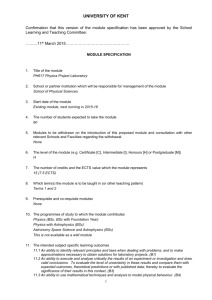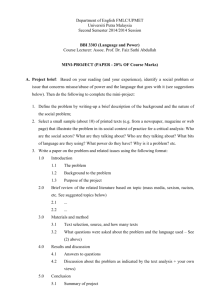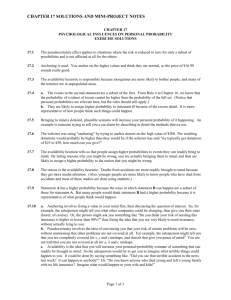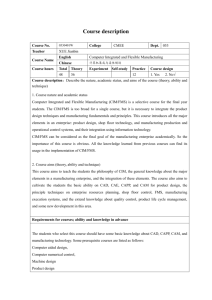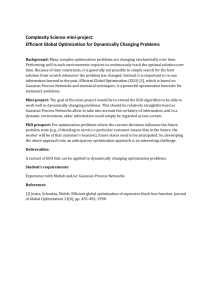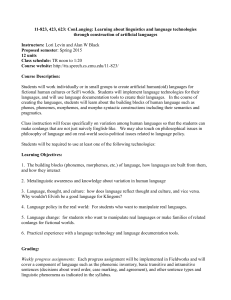Chapter 16
advertisement
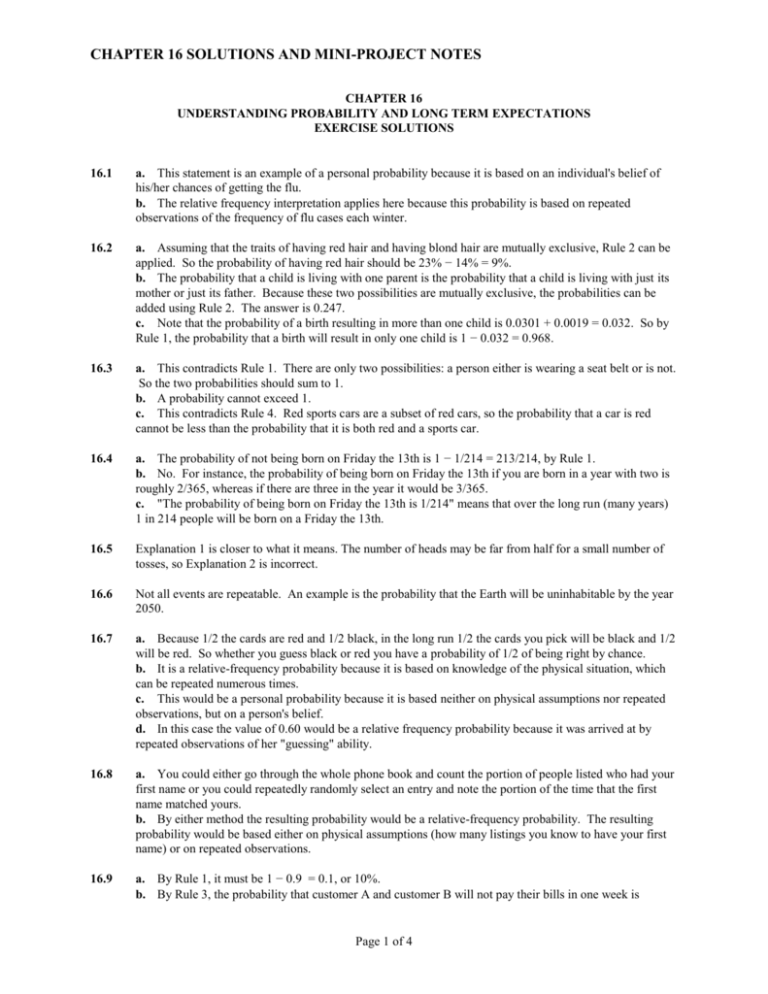
CHAPTER 16 SOLUTIONS AND MINI-PROJECT NOTES CHAPTER 16 UNDERSTANDING PROBABILITY AND LONG TERM EXPECTATIONS EXERCISE SOLUTIONS 16.1 a. This statement is an example of a personal probability because it is based on an individual's belief of his/her chances of getting the flu. b. The relative frequency interpretation applies here because this probability is based on repeated observations of the frequency of flu cases each winter. 16.2 a. Assuming that the traits of having red hair and having blond hair are mutually exclusive, Rule 2 can be applied. So the probability of having red hair should be 23% − 14% = 9%. b. The probability that a child is living with one parent is the probability that a child is living with just its mother or just its father. Because these two possibilities are mutually exclusive, the probabilities can be added using Rule 2. The answer is 0.247. c. Note that the probability of a birth resulting in more than one child is 0.0301 + 0.0019 = 0.032. So by Rule 1, the probability that a birth will result in only one child is 1 − 0.032 = 0.968. 16.3 a. This contradicts Rule 1. There are only two possibilities: a person either is wearing a seat belt or is not. So the two probabilities should sum to 1. b. A probability cannot exceed 1. c. This contradicts Rule 4. Red sports cars are a subset of red cars, so the probability that a car is red cannot be less than the probability that it is both red and a sports car. 16.4 a. The probability of not being born on Friday the 13th is 1 − 1/214 = 213/214, by Rule 1. b. No. For instance, the probability of being born on Friday the 13th if you are born in a year with two is roughly 2/365, whereas if there are three in the year it would be 3/365. c. "The probability of being born on Friday the 13th is 1/214" means that over the long run (many years) 1 in 214 people will be born on a Friday the 13th. 16.5 Explanation 1 is closer to what it means. The number of heads may be far from half for a small number of tosses, so Explanation 2 is incorrect. 16.6 Not all events are repeatable. An example is the probability that the Earth will be uninhabitable by the year 2050. 16.7 a. Because 1/2 the cards are red and 1/2 black, in the long run 1/2 the cards you pick will be black and 1/2 will be red. So whether you guess black or red you have a probability of 1/2 of being right by chance. b. It is a relative-frequency probability because it is based on knowledge of the physical situation, which can be repeated numerous times. c. This would be a personal probability because it is based neither on physical assumptions nor repeated observations, but on a person's belief. d. In this case the value of 0.60 would be a relative frequency probability because it was arrived at by repeated observations of her "guessing" ability. 16.8 a. You could either go through the whole phone book and count the portion of people listed who had your first name or you could repeatedly randomly select an entry and note the portion of the time that the first name matched yours. b. By either method the resulting probability would be a relative-frequency probability. The resulting probability would be based either on physical assumptions (how many listings you know to have your first name) or on repeated observations. 16.9 a. By Rule 1, it must be 1 − 0.9 = 0.1, or 10%. b. By Rule 3, the probability that customer A and customer B will not pay their bills in one week is Page 1 of 4 CHAPTER 16 SOLUTIONS AND MINI-PROJECT NOTES (0.1)(0.1)= 0.01, or 1%. The assumption has been made that customer A not paying in one week does not influence whether or not customer B pays in a week. Yes, it seems reasonable to assume that there will, in general, be no connection between these two events. 16.10 No. To say the probability is 5/10, you are assuming that the events are mutually exclusive, meaning that if you got an interesting piece of mail on Monday you could not get one on Tuesday, and so on. But you could easily get an interesting piece of mail on two of these days or all of them. (You would need to subtract the probability that you would receive an interesting piece of mail on two or more of these days.) 16.11 We would have to assume independence, so that if a person belongs to one of these organizations it would not make them more or less likely to belong to the other. This assumption is probably not valid because older people are more likely to belong to AAA, and only those over 50 are allowed to belong to AARP. 16.12 By Rule 4, alternative A must have a higher probability than B because bank tellers who are active in the feminist movement are a subset of all bank tellers. 16.13 This is a relative-frequency probability. It means that over the long run the portion of times luggage will be temporarily lost is 1/176. 16.14 a. This probability was most likely determined by observing the relative frequency. Flights from New York to San Francisco were observed and their punctuality over a long period of time was recorded. b. This probability was determined by repeated observations of how often Americans read a book for pleasure. c. This probability could have been most easily determined by physical knowledge of the situation, assuming all possible poker hands are equally likely and determining the proportion of them that result in four of a kind. 16.15 a. Whatever the birth month of the first person, the probability that the second person was born in that same month is 1/12. By Rule 1 the probability of a different month is therefore 1 − 1/12 = 11/12. You could also notice that for the second person, 11 out of the 12 months would not match the first person's birth month, so the probability of a different month is 11/12. b. Two months have been taken by the first two people, so there are ten left. If the third person was born in any of those ten months, their birth month would be different. Therefore, the probability is 10/12. c. If parts a and b both happen, then all three were born in different months. The probability of this happening can be found by multiplying the probabilities: (11/12)(10/12) = 110/144 or 0.76. d. If part a and part b did not both happen this would mean that at least two people have the same birth month. In part c we found the probability of the complement of this to be 110/144. Therefore, by Rule 1 we know that the probability that parts a and b do not both happen is 1 − 110/144 = 34/144 = 0.236. Hence, the probability that at least two of the people were born in the same month is 34/144 or 0.236. 16.16 Here is an example provided by a student: I think that the probability that I will finish my math homework by the due date is 70%. I also believe that I will receive an A with a probability of 60%. I will need to turn in the assignment on time in order to get an A, so getting an A is a subset of turning in the assignment. This prediction is coherent because 60% is smaller than 70%. 16.17 a. These are not likely to be independent because spouses' political views are very likely to influence each other, and spouses are likely to belong to the same political party. b. The temperature plays a role in whether or not it snows so these can not be independent. c. These will be independent because the numbers are chosen randomly each week and knowledge of one week's numbers will not give you any knowledge of the second week's numbers. d. These events are probably independent because the Dow Jones Industrial Average is not likely to be affected by earthquakes and earthquakes are clearly not affected by the Dow Jones Industrial Average. You might argue that they are not independent because a major earthquake in a city like New York, Los Angeles or San Francisco would probably play havoc with the stock market. This is an acceptable answer if you Page 2 of 4 CHAPTER 16 SOLUTIONS AND MINI-PROJECT NOTES provide an explanation. 16.18 a. The probability that you do not find money is 1 − 0.1 = 0.9. b. The probability of finding money for the first time on the third try would be (0.9)(0.9)(0.1) = 0.081. c. This is the accumulated probability at the third try, which is the sum of the individual probabilities for tries 1, 2 and 3. It is thus (0.1) + (0.9)(0.1) + (0.9)(0.9)(0.1) = 0.1 + 0.09 + 0.081 = 0.271. 16.19 a. 99/100 b. (99/100)(1/100) = .0099. 16.20 a. The probability of making it 70 years without being struck by lightning would be (684,999/685,0000) 70. b. If the average lifetime is 70 years, then Krantz's probability should be 1 − (684,999/685,000)70, or one minus the probability in part a. c. These probabilities do not apply to any particular person. Your chances depend on things like where you live and what you do during storms. d. About (290,000,000) (1/685,000), or approximately 423 people. 16.21 a. The expected commute time is (20 min)(0.2) + (15 min)(0.8) = 16 minutes. b. No, the commute times are always either 15 or 20 minutes. This is just an average over the long run. 16.22 a. You lose $3 if the births are all girls, so the probability that you lose $3 is (0.49)(0.49)(0.49) = 0.117649. Your friend loses $3 if they are all boys, so the probability is (0.51)(0.51)(0.51) = 0.132651. b. Expected value = (+$1)(0.51) + ($1)(0.49) = 0.51 0.49 = 0.02 or 2 cents for each birth. c. Making 2 cents on each birth, after 1,000 births you make about ($0.02)(1,000) = $20. 16.23 It costs $1 to play, so the possible outcomes are $19, $1 and −$1. The expected value is ($19)(0.012) + ($1)(0.137) + (−$1)(0.851) = −$0.486. So your expected loss would be about 49 cents for each dollar played. 16.24 Your expected grade point average would be (4.0)(0.3) + (3.0)(0.7) = 3.3. You would not necessarily get this in any one quarter; expected value gives you only a long-term average. Even four or five years of college may not be enough to reach this long-term average exactly. 16.25 The possible number of parents is 2 with probability 0.72, 1 with combined probability for the mother and father of 0.25, and 0 with probability 0.03. The expected value for the number of parents is (2)(0.72) + (1)(0.25) = 1.69. This is not particularly meaningful for this example because we cannot interpret 1.69 parents. 16.26 The best examples are for discrete data in which the expected value is also the mode. For instance, suppose a small box of raisins (sultanas) contains 19 pieces with probability 1/10, 20 with probability 8/10 and 21 with probability 1/10. Then the expected value is 20 raisins, which is also the most likely value. 16.27 The probability that results in a break-even situation is (cost)/(cost+$5,000). To figure this out, call the probability of an accident p. Then the insurance company earns your cost with probability (1−p) and loses $5,000 with probability p. The expected value is: (cost)(1−p) + (−$5,000)(p) = cost − (cost+$5,000)(p). Setting this to zero and solving for p gives the answer. In general, you will find that the answer is much higher than your own personal probability. (That's how the insurance companies pay for their expenses and make a profit.) 16.28 It is based on personal probability. The event of an asteroid that large hitting the earth has not occurred often enough to find a long-run relative frequency. Page 3 of 4 CHAPTER 16 SOLUTIONS AND MINI-PROJECT NOTES NOTES ABOUT THE MINI-PROJECTS FOR CHAPTER 16 Mini-Project 16.1 The purpose of this mini-project is to learn firsthand that the tendency of most people is to ignore Rule 4 in this setting. The report for this project will be fairly short and should explain whether or not it was difficult to convince people of the right answer. Mini-Project 16.2 Make sure the plot uses all flips accumulated up to that point and not just the previous ten. If done correctly, the value on the vertical axis should start settling down to a constant as the number of flips (on the horizontal axis) increases. If flipping is done in an unbiased way that constant should be about 0.50. That is what the relativefrequency interpretation of the probability of a head would predict. Mini-Project 16.3 The purpose of this project is to demonstrate that personal probabilities can be quite variable and still all be correct. In contrast, if we all agree on the physical assumptions, then we should all agree on the relative-frequency probability in this project. The probability of a heart should be given as 1/4 by everyone. Mini-Project 16.4 Make sure to count the cost of playing when computing the expected value for each game. The interpretation is that this is what it costs per play in the long run. There is no correct answer to part b, although if one game has a substantially higher expected value it would probably be the desired game. The psychological impact of potentially winning a large amount must also be considered. Page 4 of 4
